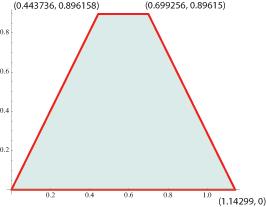What is the smallest dilation of a quadrilateral in $\mathbb{R}^d$? This may be an open problem; my question is: Is this indeed open?
It will take me some time to explain the terms. The notion of dilation derives from Gromov, as far as I know (He defines a version in Metric Structures for Riemannian and Non-Riemannian Spaces, p.11, although he called it distortion). I came upon it myself via $t$-spanners.
The version in which I am interested is this. Let $P$ be a polygon (its boundary, not its interior), and $x,y$ two points on $P$. You can think of $P$ in $\mathbb{R}^2$, but also $\mathbb{R}^3$ and $\mathbb{R}^d$ for $d>3$ are interesting. Define $\delta(x,y)$ as the maximum (supremum) of $d_P(x,y) / | x y |$, where $d_P(x,y)$ is the distance between $x$ and $y$ following $P$ (the shortest path staying on the closed path that consitutes $P$), and $|xy|$ is the Euclidean distance in $\mathbb{R}^d$. Thus $\delta(x,y)$ measures how much $P$ dilates w.r.t. Euclidean distance. I am interested in the minimum value $\delta(P)$ of $\delta(x,y)$ over all $x,y \in P$, for all $n$-gons $P$, for fixed $n$.
Example 1. If $P$ is a unit square, then $\delta(x,y)$ for $x,y$ opposite corners is $\sqrt{2}$, but $\delta(P)=2$ because with $x,y$ midpoints of opposite sides, $\delta(x,y)= 2/1$.
Example 2.
If $P$ is an equilateral triangle, $\delta(P)=2$, as shown in the figure.
In fact, the dilation of any triangle is $\ge 2$ [Lemma 7 in the 2nd paper below].

Example 3. It is known the the dilation of any closed curve $C$ satisfies $\delta(C) \ge \pi/2$, with equality achieved only by the circle. [Corollary 23 in the first paper below.] This is (apparently) due to Gromov.
So I finally come to my question. By reading these two papers, "Geometric Dilation of Closed Planar Curves: New Lower Bounds," and "On Geometric Dilation and Halving Chords," it appears to me that the minimum dilation of a quadrilateral in $\mathbb{R}^2$ (and $\mathbb{R}^d$) is not known. I had heard this was the case three years ago in a seminar in Brussels, but (a) I didn't quite believe it, (b) it was hearsay, and (c) it is now out of date. I am trying to clarify with the authors of these papers, but in parallel I would appreciate any information on the status of this question. The latter paper cited above proves a lower bound of $4 \tan(\pi/8) \approx 1.66$ (if I have interpreted it correctly).
Addendum. I don't want to close-out this question, but I have heard from one of the authors of the above cited papers, and indeed it appears that the dilation of a planar quadrilateral is unknown [as of July 2010, the original posting date]. So I have tentatively tagged this as an open-problem, and I will update if new information surfaces. Thanks for everyone's interest and input!

 ]
]
